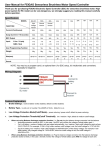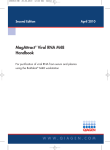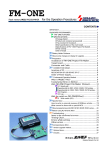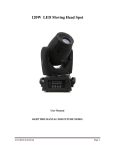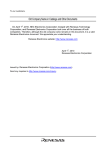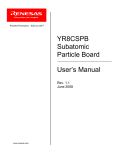Download S550-MFW1U User`s Manual
Transcript
Multifunctional Flash Microcomputer Programmer S550-MFW1U Operation Manual Sunny Giken Inc. Multifunctional Flash Microcomputer Programmer S550-MFW1U The contents of this manual may be revised without notice. We, Sunny Giken Inc. shall not be responsible for any damages and/or losses caused by using this product and/or the software attached to this product claimed by users and/or any intermediaries. Specifications of this product and/or the software attached to this product may be modified without notice for improvement. The names of systems, products, and/or services used in this manual are either registered trademarks or trademarks of each manufacturer. The captions of the TM and (R) are not mentioned in this manual. Multifunctional Flash Microcomputer [S550-MFW1U] Operation Manual 1 1 Outline ........................................................................................................................................................3 1.1 Precautions ..........................................................................................................................................3 1.2 System Configuration..........................................................................................................................4 2 Specifications ..............................................................................................................................................5 2.1 General Specifications.........................................................................................................................5 2.2 Function Specifications .......................................................................................................................6 2.3 Programmable Devices........................................................................................................................7 3 Panel Description .......................................................................................................................................8 3.1 MFW1U Unit .......................................................................................................................................8 3.2 Parallel Adapter.................................................................................................................................10 4 Setting Up.................................................................................................................................................12 4.1 PC + Parallel Programming..............................................................................................................12 4.2 PC + Serial Programming .................................................................................................................13 4.3 PC + Onboard Programming ............................................................................................................14 4.4 Standalone Parallel Programming ...................................................................................................15 4.5 Standalone Serial Programming ......................................................................................................16 4.6 Standalone Onboard Programming..................................................................................................17 5 Connector Pin Specifications for Serial Programming ..........................................................................18 5.1 Connector (MFW1U Unit).................................................................................................................18 5.2 Pin Assignment (MFW1U Unit) .......................................................................................................18 5.3 Serial Programming Cable................................................................................................................19 5.4 Connection Circuit Example for the MFW1U .................................................................................20 6 Updating Firmware..................................................................................................................................38 7 MFW1U Standalone Operation...............................................................................................................39 7.1 Standalone Programming to Parallel Adapter ................................................................................39 7.2 Standalone Programming to Serial Adapter....................................................................................40 7.3 Standalone Programming to User Target Board.............................................................................40 7.4 Initializing Memory...........................................................................................................................41 7.5 List of LED Status.............................................................................................................................42 7.6 List of Beep Sounds ...........................................................................................................................42 8 Contact Check...........................................................................................................................................43 9 Installing USB Driver ..............................................................................................................................44 9.1 Windows 7(32bit) ...............................................................................................................................44 9.2 Windows 7(64bit) ...............................................................................................................................46 9.3 Others (Windows XP, 2000, Me, 98) .................................................................................................48 Multifunctional Flash Microcomputer [S550-MFW1U] Operation Manual 2 1 Outline 1.1 Precautions Thank you for purchasing our product S550-MFW1U, the Multifunctional Flash Microcomputer Programmer. Please read this operation manual carefully to understand the function of this product for effective and stable operation. Please beware that Sunny Giken Inc. shall have no liability for any damage and/or troubles caused by misuse or careless handling. 1) General Caution Please follow the precautions mentioned below to avoid hazards such as fire, burns, electric shock, and/or injures. • Make sure that the power switch of this product is turned OFF and your hands are clean and dry when an AC adapter is plugged in. • Use this product under proper environment. • Never place this product up-side-down or lateral side facing to table. • Handle this product with care to avoid fall and/or physical shock. • Never take this product apart and/or modify by yourself. 2) Use Environment • Unusable environment Dusty place Place in the presence of corrosive gasses Place exposed to direct sunlight Place surrounded by equipment which originates noises Place with severe mechanical shock and/or constant mechanical vibration • Ambient temperature 0°C to +40°C Humidity: below 80% (non condensing) • Prevention of electrostatic buildup for operation of this product and devices is recommended. 3) Storage • Place this product into the packing box which had been delivered when your purchase and store at shaded place with the ambient temperature of -10°C to +40°C and below 80% of humidity (non condensing) for long term storage. 4) Transportation • In case the product is needed to be relocated, use the packing box which had been delivered when your purchase. 5) Cleaning • Wipe the product with soft and clean fabric. Never use any sort of organic solvent such as benzine that may cause this product deteriorated. Multifunctional Flash Microcomputer [S550-MFW1U] Operation Manual 3 1.2 System Configuration The entire system configuration of the Multifunctional Flash Microcomputer Programmer (hereinafter called “MFW1U”) is illustrated below. MFW Control Software USB Connecting Cable PC: IBM PC/AT Compatible OS: Windows98, Me, 2000, XP, Windows7(32bit/64bit) DC Cable (for Oversea) Parallel adapter Cable for serial programming (hereinafter called the "serialcable") Target board or connector at the serial adapter side should be prepare by user.) MFW1U unit Serial adapter Target board Prepared by user Up to 8 adapters can be attached. Gang prgramming) * The AC adapter is not attached for the export-product. * Refer to the “4. Setting Up” for detailed and varied connection. Multifunctional Flash Microcomputer [S550-MFW1U] Operation Manual 4 2 Specifications 2.1 General Specifications Unit of the MFW1U MFW1U DC + 9V lower than 1A AC adapter attached (for domestic use only) Power capacity (Use an attached DC cable for oversea use.) Ambient temperature: 0°C to 40°C Use environment Humidity: below 80% (non condensing) Storage Ambient temperature: -10°C to +40°C environment Power draw AC 100V lower than 15VA 50/60 Hz (AC adapter) Outer dimensions 125 (W) x 100 (D) x 25 (H) mm (Projection not included) Weight Less than 400g (only unit) CE mark obtained (EMI: EN55011 Group1 Class A, EMS: EN61000-6-2) Oversea standards FCC compliance This device complies with part 15 of the FCC Rules. Operation is subject to the following two conditions; (1) This device may not cause harmful interference, and (2) this device must accept any interference received, including interference that may cause undesired operation. Parallel Adapter Outer 162 (W) x 53 (D) x 16 (H) mm (Projection not included) dimensions Weight Less than 400g * Beware that the shape of the IC socket of the parallel adapter is varied from to be attached device type. The height (16mm) mentioned at the above “Outer dimensions” is only size of the case. The polarity of this DC cable is illustrated below. 500mm Wire color Multifunctional Flash Microcomputer [S550-MFW1U] Operation Manual RED:DC+9V BLACK:GND 5 2.2 Function Specifications Programmable MCU Operation Mode Renesas Electronics On-chip Flash Memory Microcomputer Parallel I/O mode (gang programmable: up to 8 devices can be programmed at once.) <Auto device set number detection and contact check function are available> Standard serial I/O mode (clock synchronous serial I/O and single wire clock asynchronous serial I/O(applicable to R8C Family )) * Clock asynchronous serial I/O mode not supported. PC + parallel programming PC + serial programming Program Mode PC + onboard programming Standalone parallel programming Standalone serial programming Standalone onboard programming Program data Size PC control Software Interface Max: 1Mbyte All the operation can be achieved from your PC with easy-to-operate GUI (graphic user interface). Applicable to the Win98, Me, 2000, XP, 7(32bit/64bit) USB 1.1 supported (Full-speed Mode) Multifunctional Flash Microcomputer [S550-MFW1U] Operation Manual 6 2.3 Programmable Devices The devices from the Renesas Electronics On-chip Flash Memory Microcomputer M16C Family are programmable by the MFW1U. Some of devices are still under evaluation or not programmable. Refer to the file “Programmable Device List” in an attachment floppy disk.Contact Sunny Giken Inc. for the latest information. Multifunctional Flash Microcomputer [S550-MFW1U] Operation Manual 7 3 Panel Description 3.1 MFW1U Unit External views of the MFW1U are shown and its parts such as switches, LEDs, and connectors are also described. • Top view S550-MFW1U M ult i Flash W riter SERIAL SOCKET TARGET PARALLEL SOCKET POWER START PASS ID ERR Switch/LED POWER Switch LED Buzzer FAIL Function Power Off/ON switch (Power lamp available) PARALLEL SOCKET SERIAL SOCKET SERIAL TARGET PASS Starts programming. Data that had been loaded can be cleared by pressing the “START” switch more than 5 seconds. Turns it ON when programming target is parallel adapter with definition by PC. Turns it ON when programming target is serial adapter with definition by PC. Turns it ON when programming target is user target board with definition by PC. Turns it ON when serial programming is successful. ID ERR Turns it ON when result of serial programming is ID_ERR. FAIL Turns it ON when serial programming is failed. START Sounds when operation is completed or error is issued. Multifunctional Flash Microcomputer [S550-MFW1U] Operation Manual 8 • Back view USB DC9VIN Connector Function DC9VIN DC + 9V power jack φ5.15 holes, Center φ1.65mm (compliance:EIAJ RC-5320 class3) USB USB communication connector (connected to PC) • Left-hand side view SERIAL Connector SERIAL Function Serial programming connector for target board or serial adapter. • Right-hand side view PARALLEL Connector PARALLEL Function Parallel programming connector for parallel adapter. Multifunctional Flash Microcomputer [S550-MFW1U] Operation Manual 9 3.2 Parallel Adapter At the next, external views of the parallel adapter are shown and its parts such as LEDs and connectors are also described. LED/Connector Function Socket Mounter socket for device programming. PASS LED Turns it ON when parallel programming is successful. FAIL LED Turns it ON when parallel programming is failed. Connector 1 Parallel programming connector from the MFW1U. Gang parallel programming connector when more than one parallel Connector 2 adapters attached. * The shape of the IC socket of the parallel adapter is varied from to be attached device type. Refer to separate “Programmable Device List” for your order. * Up to 8 parallel adapters can be connected and programmed at once (gang programming). But to be gang programmed devices should be the same type to avoid breakage of devices. Multifunctional Flash Microcomputer [S550-MFW1U] Operation Manual 10 Attaching parallel adapters Secure the attachment by placing latch(es) to avoid fail-to-make of adapters and safer carriage when more than one adapters are to be attached (gang programming) to the MFW1U. Latch-placement for only device mounter socket side is acceptable but securing also at the topside is reliable and recommended. The attachment figure is shown below Latch(es) at the top side Latch(es) at mounter socket side M2.6 Screw * Unscrew the M2.6 screws that hold a case cover and screw and attach adapters by referring the above illustration. * Screwing to the MFW1U unit is not applicable. Multifunctional Flash Microcomputer [S550-MFW1U] Operation Manual 11 4 Setting Up 4.1 PC + Parallel Programming Connection instructions for parallel programming by PC operation is illustrated below. USB Connection Cable DC Cable (for Oversea) MFW Control Software PC: IBM PC/AT Compatible OS: Windows98, Me, 2000, XP, 7(32bit/64bit) Parallel adapter #1 Parallel adapter #2 MFW1U unit Parallel adapter #8 Up to 8 adapters can be attached. Gang prgramming) * Up to 8 parallel adapters can be connected and programmed at once (gang programming). Devices to be gang programmed should be the same type in order to avoid breakage of the devices. * Beware that the power of the MFW1U is OFF when attaching parallel adapter(s). Multifunctional Flash Microcomputer [S550-MFW1U] Operation Manual 12 4.2 PC + Serial Programming Connection instructions for serial programming by PC operation is illustrated below. MFW Control Software USB Connection Cable PC: IBM PC/AT Compatible OS: Windows98, Me, 2000, XP, 7(32bit/64bit) DC Cable (for Oversea) Serial cable (Connector at the serial adapter side shuold be prepared by user.) MFW1U unit Serial adapter * Power supply to the serial adapter for serial programming is provided by the MFW1U via Vcc pins. (Particular power supply is not required.) * A serial adapter can be prepared by obtaining the IC socket type programming board made by Renesas Electronics. Some modification to the board is needed since the board mounts Vcc3.3V/5V switch circuit. Please contact Sunny Giken Inc. before operation. Multifunctional Flash Microcomputer [S550-MFW1U] Operation Manual 13 4.3 PC + Onboard Programming Connection instructions for serial programming to a user target board by PC operation is illustrated below. MFW Control Software USB Connection Cable PC: IBM PC/AT Compatible OS: Windows98, Me, 2000, XP, 7(32bit/64bit) DC Cable (for Oversea) Serial cable(Connector at the serial adapter side shuold be prepared by user.) MFW1U unit DC power for board Target board Prepared by user V cc Usage should be Vcc=3.3V ± 5% or 5V ± 5% * Power supply to the MFW1U for serial programming to a user target board is provided by a user target board via Vcc pins. Attach the AC adapter to supply power when the current capacity of the target board is insufficient since the maximum current consumption of the MFW1U for serial programming is 200mA. Multifunctional Flash Microcomputer [S550-MFW1U] Operation Manual 14 4.4 Standalone Parallel Programming Connection instructions for standalone parallel programming by the MFW1U after downloading data from PC is illustrated below. DC Cable (for Oversea) Parallel adapter #1 MFW1U unit Parallel adapter #2 Parallel adapter #8 Up to 8 adapters can be attached. (Gang prgramming) * Standalone parallel programming is available unless data update is occurred since downloaded data from PC to the MFW1U such as lock bit, data and several settings retains at the MFW1U even if the power switch is turned OFF. Simple operation for everyone without a complicated setting to PC is available by selecting * Up to 8 parallel adapters can be connected and programmed at once (gang programming). Devices to be gang programmed should be the same type in order to avoid breakage of devices. * Beware that the power of the MFW1U is OFF when attaching parallel adapter(s). * Not connect a USB cable, when standalone parallel programming by the MFW1U. Multifunctional Flash Microcomputer [S550-MFW1U] Operation Manual 15 4.5 Standalone Serial Programming Connection instructions for standalone serial programming by the MFW1U after downloading data from PC to a serial adapter is illustrated below. DC Cable (for Oversea) Serial cable (Connector at the serial adapter side shuold be prepared by user.) MFW1U unit Serial adapter * Standalone serial programming is available unless data update is occurred since downloaded data from PC to the MFW1U such as lock bit, data and several settings retains at the MFW1U even if the power switch is turned OFF. Simple operation for everyone without a complicated setting to PC is available by selecting * Power supply to the serial adapter for serial programming is provided by the MFW1U via Vcc pins. (Particular power supply is not required.) * A serial adapter can be prepared by obtaining the IC socket type programming board made by Renesas Electronics. Some modification to the board is needed since the board mounts Vcc3.3V/5V switch circuit. Please contact Sunny Giken Inc. before operation. * All the settings are stored at the MFW1U unit at the time of termination of the PC control software (mfw1.exe). Therefore, when Erase, Program, or Verify is desired, please make sure the Action setting is set to Erase, Program, and Verify before termination. * Not connect a USB cable, when standalone serial programming by the MFW1U. Multifunctional Flash Microcomputer [S550-MFW1U] Operation Manual 16 4.6 Standalone Onboard Programming Connection instructions for standalone serial programming by the MFW1U after downloading data from PC to a user target board is illustrated below. DC Cable (for Oversea) Serial cable (Connector at the serial adapter side shuold be prepared by user.) DC power for board Target board Prepared by user Vcc MFW1U unit Usage should be V cc=3.3V 5% or 5V * Standalone serial programming is available unless data update is occurred since downloaded data from PC to the MFW1U such as lock bit, data and several settings retains at the MFW1U even if the power switch is turned OFF. Simple operation for everyone without a complicated setting to PC is available by selecting. * Power supply of the MFW1U for serial programming is provided by a user target board via Vcc pins. Attach the AC adapter to supply power when the current capacity of the target board is insufficient since the maximum current consumption of the MFW1U for serial programming is 200mA. * All the settings are stored at the MFW1U unit at the time of termination of the PC control software (mfw1.exe). Therefore, when Erase, Program, or Verify is desired, please make sure the Action setting is set to Erase, Program, and Verify before termination. * Not connect a USB cable, when standalone serial programming by the MFW1U. Multifunctional Flash Microcomputer [S550-MFW1U] Operation Manual 17 5 Connector Pin Specifications for Serial Programming 5.1 Connector (MFW1U Unit) Model Name: HIF2FC-10PA-2.54DS Made by Hirose Electric 5.2 Pin Assignment (MFW1U Unit) The signal name and the direction are what was seen from the writer side. Pin No. Signal Name Description Direction - 1 Vcc When to be programmed target is: Serial adapter: power is supplied to serial adapter from the MFW1U via Vcc pins. User prepared target board: power is supplied to the MFW1U via Vcc pins from target board prepared by user. (Note 1) 2 BUSY Busy signal input for serial programming 3 CLK Clock signal output for serial programming Output 4 TXD Transmission data for serial programming Output 5 CE CE signal output for serial programming Output 6 EPM EPM signal output for serial programming Output 7 GND Signal ground 8 RESET RESET signal output for serial programming Output 9 CNVss CNVss (Vpp) signal output for serial programming Output 10 RXD Receiving data for serial programming Input - Input Note 1: Attach the AC adapter to supply power when the current capacity of the target board is insufficient since the maximum current consumption of the MFW1U for serial programming is 200mA. Usage of Vcc should be 3.3V±5% or 5V±5%. 9Pin 1Pin SERIAL 10Pin Multifunctional Flash Microcomputer [S550-MFW1U] Operation Manual 2Pin 18 5.3 Serial Programming Cable Attached Serial Programming Cable is designed as a straight cable. Cut one-side of the connection part and attach a proper connector to your board by reference of the pin-assignment shown above if the connection part is not matched. In this case, a cable length for a serial programming cable should be less than 500mm. Be sure to arrange the total length between cable and the target CPU is less than 500mm even if the length of a serial cable is less than 500mm. The following figure shows the cable polarity: 1Pin 500mm Connector Model: HIF3BA-10D-2.54R Manufactured by Hirose Electrics * As for serial I/O mode of M16C/20 and M16C/21 Group, an exclusive programming connector ‘MFW-20SP’ is necessary. Serial cable Multifunctional Flash Microcomputer [S550-MFW1U] Operation Manual MFW-20S MFW1U unit 19 5.4 Connection Circuit Example for the MFW1U Circuit diagram examples for serial programming under customer oriented MCU circuit design are described below (1) M16C/60([double power supplies] removed), M16C/80, M32C/80([double power supplies] removed) , R32C/100([double power supplies] removed) Series, M16C/24 Group Target board prepared by user MCU peripheral circuit MCU TXD Vcc RXD SCLK BUSY Note2 Note3 CE EPM Note4 Reset circuit CNVss Note6 Pull-up or Pull-down Note5 Note1 1 2 3 4 5 6 7 8 9 10 RESET Vss Serial cable Vcc CLK CE GND CNVss BUSY TXD EPM RESET RXD MFW1U unit Diagram 1 Note 1. Power supply of the MFW1U for serial programming is provided by a user target board via Vcc pins. Connect the power of the board to the Vcc terminal directory. Attach the AC adapter to supply power when the current capacity of the target board is insufficient since the maximum current consumption of the MFW1U for serial programming is 200mA. Usage of Vcc should be 3.3V±5% or 5V±5%. Note 2. Isolate TXD, RXD, SCLK, and/or BUSY terminals from the MCU peripheral circuit by jumper, analog switch, three state, etc. when serial programming is achieved. Isolation can be omitted when those signal statuses are output from the MCU peripheral circuit. Resistance should be 4.7KΩ or over when pull-up is achieved to these signals. Note 3. Execute the same procedure as “Note 2” for CE and EPM terminals. Or only isolation process by achieving “pull up/down” without the MFW1U connection is also applicable. On-board direct fix is also available of the CE terminal for H level and the EPM terminal Multifunctional Flash Microcomputer [S550-MFW1U] Operation Manual 20 for L level when these terminals are not connected. Note 4. Connect the MCU CNVss terminal to the CNVss terminal of the MFW1U unit by achieving “pull up/down” with resistance of 4.7KΩ. It also can be defined to H level by switching the jumper as well as CE and EPM terminals when serial programming. No connection to the MFW1U is not required for this operation. Note 5. Connect the reset terminal of the user target board MCU to the RESET terminal of the MFW1U directly when the reset circuit of the user target board is “open collector output”, “CR delay circuit”, or constant current load circuit is less than dozens of μA. Execute the same procedure as “Note 2” when it is “CMOS output”. Note 6. The Vss terminal should be connected since it is signal ground. * Please combine with this example of a connection circuit, and confirm a "Hardware manual" or a "Data sheet" of each microcomputer. Multifunctional Flash Microcomputer [S550-MFW1U] Operation Manual 21 (2) M16C/60[double power supplies] ,M32C/80[double power supplies] , R32C/100[double power supplies] Series, M16C/30P Group Target board prepared by user MCU peripheral circuit MCU TXD RXD SCLK BUSY Vcc1 Note1 Vcc2 Note4 Note2 CE EPM Note6 Reset circuit CNVss Note8 Pull-up or Pull-down Note7 Note3 1 2 3 4 5 6 7 8 9 10 RESET Vss Serial cable Vcc CLK CE GND CNVss BUSY TXD EPM RESET RXD MFW1U unit Diagram 2 Note 1. Be sure to set it so that Vcc1 is greater than or equal to Vcc2. Note 2. Pull up with Vcc2. Refer to the Note5, regarding the CE terminal when Vcc1 is equal to Vcc2. Note 3. Power supply of the MFW1U for serial programming is provided by a user target board via Vcc pins. Connect the power of the board to the Vcc terminal directory. Attach the AC adapter to supply power when the current capacity of the target board is insufficient since the maximum current consumption of the MFW1U for serial programming is 200mA. Usage of Vcc should be 3.3V±5% or 5V±5%. Note 4. Isolate TXD, RXD, SCLK, and/or BUSY terminals from the MCU peripheral circuit by jumper, analog switch, three state, etc. when serial programming is achieved. Isolation can be omitted when those signal statuses are output from the MCU peripheral circuit. Resistance should be 4.7KΩ or over when pull-up is achieved to these signals. Note 5. Execute the same procedure as “Note 2” for CE and EPM terminals. Or only isolation process by achieving “pull up/down” without the MFW1U connection is also applicable. On-board direct fix is also available of the CE terminal for H level and the EPM terminal for L level when these terminals are not connected. Note 6. Connect the MCU CNVss terminal to the CNVss terminal of the MFW1U unit by Multifunctional Flash Microcomputer [S550-MFW1U] Operation Manual 22 achieving “pull up/down” with resistance of 4.7KΩ. It also can be defined to H level by switching the jumper as well as CE and EPM terminals when serial programming. No connection to the MFW1U is not required for this operation. Note 7. Connect the reset terminal of the user target board MCU to the RESET terminal of the MFW1U directly when the reset circuit of the user target board is “open collector output”, “CR delay circuit”, or constant current load circuit is less than dozens of μA. Execute the same procedure as “Note 2” when it is “CMOS output”. Note 8. The Vss terminal should be connected since it is signal ground. * Please combine with this example of a connection circuit, and confirm a "Hardware manual" or a "Data sheet" of each microcomputer. Multifunctional Flash Microcomputer [S550-MFW1U] Operation Manual 23 (3) M16C/80 Series ROM external version Target board prepared by user MCU peripheral circuit MCU Note2 TXD Vcc RXD SCLK BUSY Note4 Pull-up or Pull-down Reset circuit Note3 CNVss Note6 Note5 RESET Vss Note1 1 2 3 4 5 6 7 8 9 10 Serial cable Vcc CLK CE GND CNVss BUSY TXD EPM RESET RXD MFW1U unit Diagram 3 Note 1. Power supply of the MFW1U for serial programming is provided by a user target board via Vcc pins. Connect the power of the board to the Vcc terminal directory. Attach the AC adapter to supply power when the current capacity of the target board is insufficient since the maximum current consumption of the MFW1U for serial programming is 200mA. Usage of Vcc should be 3.3V±5% or 5V±5%. Note 2. Isolate TXD, RXD, SCLK, and/or BUSY terminals from the MCU peripheral circuit by jumper, analog switch, three state, etc. when serial programming is achieved. Isolation can be omitted when those signal statuses are output from the MCU peripheral circuit. Resistance should be 4.7KΩ or over when pull-up is achieved to these signals. Note 3. Connect the MCU CNVss terminal to Vss of the user target board, but do not connect to the CNVss terminal of the MFW1U unit. Note 4. Connect the MCU BUSY terminal to the BUSY terminal of the MFW1U unit by achieving “pull up/down” with resistance of 10KΩ. Note 5. Connect the reset terminal of the user target board MCU to the RESET terminal of the MFW1U directly when the reset circuit of the user target board is “open collector output”, “CR delay circuit”, or constant current load circuit is less than dozens of μA. Execute same procedure as “Note 2” when it is “CMOS output”. Note 6. The Vss terminal should be connected since it is signal ground. * Please combine with this example of a connection circuit, and confirm a "Hardware manual" or a "Data sheet" of each microcomputer. Multifunctional Flash Microcomputer [S550-MFW1U] Operation Manual 24 (4) M16C/50 Series Target board prepared by user MCU peripheral circuit MCU Note2 TXD Vcc RXD SCLK BUSY Reset circuit Note5 Note3 Note4 CNVss RESET Vss Note1 1 2 3 4 5 6 7 8 9 10 Serial cable Vcc CLK CE GND CNVss BUSY TXD EPM RESET RXD MFW1U unit Diagram 4 Note 1. Power supply of the MFW1U for serial programming is provided by a user target board via Vcc pins. Connect the power of the board to the Vcc terminal directory. Attach the AC adapter to supply power when the current capacity of the target board is insufficient since the maximum current consumption of the MFW1U for serial programming is 200mA. Usage of Vcc should be 3.3V±5% or 5V±5%. Note 2. Isolate TXD, RXD, SCLK, and/or BUSY terminals from the MCU peripheral circuit by jumper, analog switch, three state, etc. when serial I/O programming is achieved. Isolation can be omitted when those signal statuses are output from the MCU peripheral circuit. Resistance should be 4.7KΩ or over when pull-up is achieved to these signals. Note 3. Connect the MCU CNVss terminal to the CNVss terminal of the MFW1U unit by achieving “pull down” with resistance of 4.7KΩ. Note 4. Connect the reset terminal of the user target board MCU to the RESET terminal of the MFW1U directly when the reset circuit of user target board is “open collector output”, “CR delay circuit”, or constant current load circuit is less than dozens of μA. Execute the same procedure as “Note 2” when it is “CMOS output”. Note 5. The Vss terminal should be connected since it is signal ground. * Please combine with this example of a connection circuit, and confirm a "Hardware manual" or a "Data sheet" of each microcomputer. Multifunctional Flash Microcomputer [S550-MFW1U] Operation Manual 25 (5) M16C/1N Group Target board prepared by user MCU peripheral circuit MCU Note2 TXD Vcc RXD SCLK BUSY Note3 CE SEL Note4 Reset circuit Note7 Note5 Note6 CNVss RESET Vss Note1 1 2 3 4 5 6 7 8 9 10 Serial cable Vcc CLK CE GND CNVss BUSY TXD EPM RESET RXD MFW1U unit Diagram 5 Note 1. Power supply of the MFW1U for serial programming is provided by a user target board via Vcc pins. Connect the power of the board to the Vcc terminal directory. Attach the AC adapter to supply power when the current capacity of target board is insufficient since the maximum current consumption of the MFW1U for serial programming is 200mA. Usage of Vcc should be 3.3V±5% or 5V±5%. Note 2. Isolate TXD, RXD, SCLK, and/or BUSY terminals from the MCU peripheral circuit by jumper, analog switch, three state, etc. when serial I/O programming is achieved. Isolation can be omitted when those signal statuses are output from the MCU peripheral circuit. Resistance should be 4.7KΩ or over when pull-up is achieved to these signals. Note 3. Execute the same procedure as “Note 2” for CE terminal. Or only isolation process by achieving “pull up” without the MFW1U connection is also applicable. On-board direct fix is also available of the CE terminal for H level when these terminals are not connected. Note 4. Execute the same procedure as “Note 2” for SEL terminal. Or only isolation process by achieving “pull down” without the MFW1U connection is also applicable. On-board direct fix is also available of the SEL terminal for L level when these terminals are not connected. Note 5. Connect the MCU CNVss terminal to the CNVss terminal of the MFW1U unit by achieving “pull up/down” with resistance of 4.7KΩ. H-level fixation by jumper switching is also available. Attachment to the MFW1U is not needed for this case. Note 6. Connect the reset terminal of the user target board MCU to the RESET terminal of the MFW1U directly when the reset circuit of the user target board is “open collector output”, “CR delay circuit”, or constant current load circuit is less than dozens of μA. Execute the same procedure as “Note 2” when it is “CMOS output”. Multifunctional Flash Microcomputer [S550-MFW1U] Operation Manual 26 Note 7. The Vss terminal should be connected since it is signal ground. * Please combine with this example of a connection circuit, and confirm a "Hardware manual" or a "Data sheet" of each microcomputer. Multifunctional Flash Microcomputer [S550-MFW1U] Operation Manual 27 (6) M16C/20, M16C/21 Group Target board prepared by user MCU peripheral circuit MCU Note2 TXD Vcc RXD SCLK BUSY Note3 Reset circuit CNVss Note5 Note4 RESET Vss Note1 1 2 3 4 5 6 7 8 9 10 Serial cable Vcc CLK CE GND CNVss BUSY TXD EPM RESET RXD MFW-20SPe Note6 MFW1U unit Diagram 6 Note 1. Power supply of the MFW1U for serial programming is provided by a user target board via Vcc pins. Connect the power of board to the Vcc terminal directory. Attach the AC adapter to supply power when the current capacity of the target board is insufficient since the maximum current consumption of the MFW1U for serial programming is 200mA. Usage of Vcc should be 3.3V±5% or 5V±5%. Note 2. Isolate TXD, RXD, SCLK, and/or BUSY terminals from the MCU peripheral circuit by jumper, analog switch, three state, etc. when serial I/O programming is achieved. Isolation can be omitted when those signal statuses are output from the MCU peripheral circuit. Resistance should be 4.7KΩ or over when pull-up is achieved to these signals. Note 3. Connect the MCU CNVss terminal to the CNVss terminal of the MFW1U unit by achieving “pull down” with resistance of 4.7KΩ. Note 4. Connect the reset terminal of the user target board MCU to the RESET terminal of the MFW1U directly when the reset circuit of the user target board is “open collector output”, “CR delay circuit”, or constant current load circuit is less than dozens of μA. Execute the same procedure as “Note 2” when it is “CMOS output”. Note 5. The Vss terminal should be connected since it is signal ground. Note 6. Adaptor for the target ‘MFW-20SPe’ for exclusive use is required in serial programming. * Please combine with this example of a connection circuit, and confirm a "Hardware manual" or a "Data sheet" of each microcomputer. Multifunctional Flash Microcomputer [S550-MFW1U] Operation Manual 28 (7) M16C/22 Group Target board prepared by user MCU peripheral circuit MCU Note2 TXD Vcc RXD SCLK BUSY Note3 CE Note4 CNVss Reset circuit Note6 Note5 RESET Vss Note1 1 2 3 4 5 6 7 8 9 10 Serial cable Vcc CLK CE GND CNVss BUSY TXD EPM RESET RXD MFW1U unit Diagram 7 Note 1. Power supply of the MFW1U for serial programming is provided by a user target board via Vcc pins. Connect the power of the board to the Vcc terminal directory. Attach the AC adapter to supply power when the current capacity of the target board is insufficient since the maximum current consumption of the MFW1U for serial programming is 200mA. Usage of Vcc should be 3.3V±5% or 5V±5%. Note 2. Isolate TXD, RXD, SCLK, and/or BUSY terminals from the MCU peripheral circuit by jumper, analog switch, three state, etc. when serial I/O programming is achieved. Isolation can be omitted when those signal statuses are output from the MCU peripheral circuit. Resistance should be 4.7KΩ or over when pull-up is achieved to these signals. Note 3. Execute the same procedure as “Note 2” for CE terminal. Or only isolation process by achieving “pull up” without the MFW1U connection is also applicable. On-board direct fix is also available of the CE terminal for H level when these terminals are not connected. Note 4. Connect the MCU CNVss terminal to the CNVss terminal of the MFW1U unit by achieving “pull down” with resistance of 4.7KΩ. Note 5. Connect the reset terminal of the user target board MCU to the RESET terminal of the MFW1U directly when the reset circuit of user target board is “open collector output”, “CR delay circuit”, or constant current load circuit is less than dozens of μA. Execute the same procedure as “Note 2” when it is “CMOS output”. Note 6. The Vss terminal should be connected since it is signal ground. * Please combine with this example of a connection circuit, and confirm a "Hardware manual" or a "Data sheet" of each microcomputer. Multifunctional Flash Microcomputer [S550-MFW1U] Operation Manual 29 (8) M16C/26 Group Target board prepared by user MCU peripheral circuit MCU Note2 TXD Vcc RXD SCLK BUSY CE Note3 RP Reset circuit Note6 Note4 Note5 CNVss RESET Vss Note1 1 2 3 4 5 6 7 8 9 10 Serial cable Vcc CLK CE GND CNVss BUSY TXD EPM RESET RXD MFW1U unit Diagram 8 Note 1. Power supply of the MFW1U for serial programming is provided by a user target board via Vcc pins. Connect the power of the board to the Vcc terminal directory. Attach the AC adapter to supply power when the current capacity of the target board is insufficient since the maximum current consumption of the MFW1U for serial programming is 200mA. Usage of Vcc should be 3.3V±5% or 5V±5%. Note 2. Isolate TXD, RXD, SCLK, and/or BUSY terminals from the MCU peripheral circuit by jumper, analog switch, three state, etc. when serial I/O programming is achieved. Isolation can be omitted when those signal statuses are output from the MCU peripheral circuit. Resistance should be 4.7KΩ or over when pull-up is achieved to these signals. Note 3. Execute the same procedure as “Note 2” for CE and RP terminal. Connect CE terminal to CE of MFW1U, or connect RP terminal to EPM of MFW1U. Or only isolation process by achieving “pull up/down” without the MFW1U connection is also applicable. On-board direct fix is also available of the CE terminal for H level or the RP terminal for L level when these terminals are not connected. Note 4. Connect the MCU CNVss terminal to the CNVss terminal of the MFW1U unit by achieving “pull down” with resistance of 4.7KΩ. Note 5. Connect the reset terminal of the user target board MCU to the RESET terminal of the MFW1U directly when the reset circuit of user target board is “open collector output”, “CR delay circuit”, or constant current load circuit is less than dozens of μA. Execute the same procedure as “Note 2” when it is “CMOS output”. Note 6. The Vss terminal should be connected since it is signal ground. * Please combine with this example of a connection circuit, and confirm a "Hardware manual" or a "Data sheet" of each microcomputer. Multifunctional Flash Microcomputer [S550-MFW1U] Operation Manual 30 (9) M16C/26A, M16C/28, M16C/29 Group Target board prepared by user MCU peripheral circuit MCU Note2 TXD Vcc RXD SCLK BUSY CE or P16 Note3 RP Reset circuit Note6 Note4 Note5 CNVss RESET Vss Note1 1 2 3 4 5 6 7 8 9 10 Serial cable Vcc CLK CE GND CNVss BUSY TXD EPM RESET RXD MFW1U unit Diagram 9 Note 1. Power supply of the MFW1U for serial programming is provided by a user target board via Vcc pins. Connect the power of the board to the Vcc terminal directory. Attach the AC adapter to supply power when the current capacity of the target board is insufficient since the maximum current consumption of the MFW1U for serial programming is 200mA. Usage of Vcc should be 3.3V±5% or 5V±5%. Note 2. Isolate TXD, RXD, SCLK, and/or BUSY terminals from the MCU peripheral circuit by jumper, analog switch, three state, etc. when serial I/O programming is achieved. Isolation can be omitted when those signal statuses are output from the MCU peripheral circuit. Resistance should be 4.7KΩ or over when pull-up is achieved to these signals. Note 3. Execute the same procedure as “Note 2” for CE, P16 and RP terminal. Connect CE terminal to CE of MFW1U, or connect P16 terminal to CE of MFW1U and connect RP terminal to EPM of MFW1U. Or only isolation process by achieving “pull up/down” without the MFW1U connection is also applicable. On-board direct fix is also available of the CE terminal for H level, or the P16 terminal for H level and the RP terminal for L level when these terminals are not connected. Note 4. Connect the MCU CNVss terminal to the CNVss terminal of the MFW1U unit by achieving “pull down” with resistance of 4.7KΩ. Note 5. Connect the reset terminal of the user target board MCU to the RESET terminal of the MFW1U directly when the reset circuit of user target board is “open collector output”, “CR delay circuit”, or constant current load circuit is less than dozens of μA. Execute the same procedure as “Note 2” when it is “CMOS output”. Note 6. The Vss terminal should be connected since it is signal ground. * Please combine with this example of a connection circuit, and confirm a "Hardware manual" or a "Data sheet" of each microcomputer. Multifunctional Flash Microcomputer [S550-MFW1U] Operation Manual 31 (10) M16C/2N Group Target board prepared by user MCU peripheral circuit MCU Note2 TXD Vcc RXD SCLK BUSY Note3 Reset circuit Note5 Note4 CNVss CNVss1 CNVss2 Note6 RESET Vss Note1 1 2 3 4 5 6 7 8 9 10 Serial cable Vcc CLK CE GND CNVss BUSY TXD EPM RESET RXD MFW1U unit Diagram 10 Note 1. Power supply of the MFW1U for serial programming is provided by a user target board via Vcc pins. Connect the power of the board to the Vcc terminal directory. Attach the AC adapter to supply power when the current capacity of target board is insufficient since the maximum current consumption of the MFW1U for serial programming is 200mA. Usage of Vcc should be 3.3V±5% or 5V±5%. Note 2. Isolate TXD, RXD, SCLK, and/or BUSY terminals from the MCU peripheral circuit by jumper, analog switch, three state, etc. when serial I/O programming is achieved. Isolation can be omitted when those signal statuses are output from the MCU peripheral circuit. Resistance should be 4.7KΩ or over when pull-up is achieved to these signals. Note 3. Connect the MCU CNVss terminal to the CNVss terminal of the MFW1U unit by achieving “pull down” with resistance of 4.7KΩ. Note 4. Connect the reset terminal of the user target board MCU to the RESET terminal of the MFW1U directly when the reset circuit of the user target board is “open collector output”, “CR delay circuit”, or constant current load circuit is less than dozens of μA. Execute the same procedure as “Note 2” when it is “CMOS output”. Note 5. The Vss terminal should be connected since it is signal ground. Note 6. Connect the MCU CNVss1 and CNVss2 terminal to Vss of the user target board. * Please combine with this example of a connection circuit, and confirm a "Hardware manual" or a "Data sheet" of each microcomputer. Multifunctional Flash Microcomputer [S550-MFW1U] Operation Manual 32 (11) R8C/10, R8C/11, R8C/12, and R8C/13 Group Target board prepared by user MCU peripheral circuit MCU Note2 TXD Vcc RXD Note3 MODE Note4 CNVss Reset circuit Note6 Note5 RESET Vss Note1 1 2 3 4 5 6 7 8 9 10 Serial cable Vcc CLK CE GND CNVss BUSY TXD EPM RESET RXD MFW1U unit Diagram 11 Note 1. Power supply of MFW1U is provided by a user target board via Vcc pins. Connect the power source of the board to the Vcc terminal directly. Usage of Vcc should be 3.3V plus or minus 3%, or 5V plus or minus 3%. Note 2. Isolate TXD, RXD, and/or BUSY terminals from the MCU peripheral circuit by jumper, analog switch, three state, etc. when serial I/O programming is achieved. Isolation can be omitted when those signal statuses are output from the MCU peripheral circuit. Resistance should be 4.7KΩ or over when pull-up is achieved to these signals. Note 3. Connect the MCU MODE terminal to the BUSY terminal of the MFW1U unit by achieving “pull up” with resistance of 4.7KΩ. Note 4. Connect the MCU CNVss terminal to the CLK terminal of the MFW1U unit by achieving “pull down” with resistance of 4.7KΩ. Note 5. Connect the reset terminal of the user target board MCU to the RESET terminal of the MFW1U directly when the reset circuit of user target board is “open collector output”, “CR delay circuit”, or constant current load circuit is less than dozens of μA. Execute the same procedure as “Note 2” when it is “CMOS output”. Note 6. The Vss terminal should be connected since it is signal ground. * Please combine with this example of a connection circuit, and confirm a "Hardware manual" or a "Data sheet" of each microcomputer. Multifunctional Flash Microcomputer [S550-MFW1U] Operation Manual 33 (12) R8C/LX Series Target board prepared by user MCU Vcc Note2 MODE Vref Note6 Reset circuit Note4 Note3 RESET Vss Note1 Serial cable 1 2 3 4 5 6 7 8 9 10 CE GND CNVss Vcc CLK RXD BUSY TXD EPM RESET S550-AD2e Note5 MFW1U unit Diagram 12 Note 1. Power supply of the MFW1U for serial programming is provided by a user target board via Vcc pins. Connect the power of board to the Vcc terminal directory. Attach the AC adapter to supply power when the current capacity of the target board is insufficient since the maximum current consumption of the MFW1U for serial programming is 200mA. Usage of Vcc should be 3.3V±5% or 5V±5%. Note 2. Connect the MCU MODE terminal to the CLK terminal of the MFW1U unit by achieving “pull up” with resistance of 4.7KΩ. Note 3. Connect the reset terminal of the user target board MCU to the RESET terminal of the MFW1U directly when the reset circuit of the user target board is “open collector output”, “CR delay circuit”, or constant current load circuit is less than dozens of μA. Isolate TXD, RXD, and/or BUSY terminals from the MCU peripheral circuit by jumper, analog switch, three state, etc. when it is “CMOS output”. Note 4. The Vss terminal should be connected since it is signal ground. Note 5. An exclusive programming connector ‘S550-AD1e’ or ‘S550-AD2e’ is necessary. Note 6. Connect Vref terminal to the VCC. * Please combine with this example of a connection circuit, and confirm a "Hardware manual" or a "Data sheet" of each microcomputer. Multifunctional Flash Microcomputer [S550-MFW1U] Operation Manual 34 (13) R8C Family other than R8C/10, R8C/11, R8C/12, R8C/13 Group and R8C/LX Series Target board prepared by user MCU Vcc Note2 MODE Reset circuit Note4 Note3 RESET Vss Note1 Serial cable 1 2 3 4 5 6 7 8 9 10 Vcc CLK CE GND CNVss BUSY TXD EPM RESET RXD S550-AD2e Note5 MFW1U unit Diagram 13 Note 1. Power supply of the MFW1U for serial programming is provided by a user target board via Vcc pins. Connect the power of board to the Vcc terminal directory. Attach the AC adapter to supply power when the current capacity of the target board is insufficient since the maximum current consumption of the MFW1U for serial programming is 200mA. Usage of Vcc should be 3.3V±5% or 5V±5%. Note 2. Connect the MCU MODE terminal to the CLK terminal of the MFW1U unit by achieving “pull up” with resistance of 4.7KΩ. Note 3. Connect the reset terminal of the user target board MCU to the RESET terminal of the MFW1U directly when the reset circuit of the user target board is “open collector output”, “CR delay circuit”, or constant current load circuit is less than dozens of μA. Isolate TXD, RXD, and/or BUSY terminals from the MCU peripheral circuit by jumper, analog switch, three state, etc. when it is “CMOS output”. Note 4. The Vss terminal should be connected since it is signal ground. Note 5. An exclusive programming connector ‘S550-AD1e’ or ‘S550-AD2e’ is necessary. * Please combine with this example of a connection circuit, and confirm a "Hardware manual" or a "Data sheet" of each microcomputer. Multifunctional Flash Microcomputer [S550-MFW1U] Operation Manual 35 (14) 7641, 7643, 38C2, 38K0, and 38K2 Group Target board prepared by user MCU peripheral circuit MCU Note2 TXD Vcc RXD SCLK BUSY Note3 CE Note4 CNVss Reset circuit Note6 Note5 RESET Vss Note1 1 2 3 4 5 6 7 8 9 10 Serial cable Vcc CLK CE GND CNVss BUSY TXD EPM RESET RXD MFW1U unit Diagram 14 Note 1. Power supply of the MFW1U for serial programming is provided by a user target board via Vcc pins. Connect the power of the board to the Vcc terminal directory. Attach the AC adapter to supply power when the current capacity of target board is insufficient since the maximum current consumption of the MFW1U for serial programming is 200mA. Usage of Vcc should be 3.3V±5% or 5V±5%. Note 2. Isolate TXD, RXD, SCLK, and/or BUSY terminals from the MCU peripheral circuit by jumper, analog switch, three state, etc. when serial I/O programming is achieved. Isolation can be omitted when those signal statuses are output from the MCU peripheral circuit. Resistance should be 4.7KΩ or over when pull-up is achieved to these signals. Note 3. Execute the same procedure as “Note 2” for CE terminal. Or only isolation process by achieving “pull up” without the MFW1U connection is also applicable. On-board direct fix is also available of the CE terminal for H level when these terminals are not connected. Note 4. Connect the MCU CNVss terminal to the CNVss terminal of the MFW1U unit by achieving “pull up/down” with resistance of 4.7KΩ. H-level fixation by jumper switching is also available. Attachment to the MFW1U is not needed for this case. Note 5. Connect the reset terminal of the user target board MCU to the RESET terminal of the MFW1U directly when the reset circuit of the user target board is “open collector output”, “CR delay circuit”, or constant current load circuit is less than dozens of μA. Execute the same procedure as “Note 2” when it is “CMOS output”. Note 6. The Vss terminal should be connected since it is signal ground. * Please combine with this example of a connection circuit, and confirm a "Hardware manual" or a "Data sheet" of each microcomputer. Multifunctional Flash Microcomputer [S550-MFW1U] Operation Manual 36 (15) 7542 Group Target board prepared by user MCU peripheral circuit MCU Note3 Note2 TXD Vcc RXD SCLK Note8 Reset circuit Note4 Note6 BUSY CE RP Note9 CNVss RESET Vss Note5 Note1 Serial cable 1 2 3 4 5 6 7 8 9 10 Vcc CLK CE GND CNVss BUSY TXD EPM RESET RXD MFW-20SPe Note7 MFW1U unit Diagram 15 Note 1. Power supply of the MFW1U for serial programming is provided by a user target board via Vcc pins. Connect the power of board to the Vcc terminal directory. Attach the AC adapter to supply power when the current capacity of the target board is insufficient since the maximum current consumption of the MFW1U for serial programming is 200mA. Usage of Vcc should be 3.3V±5% or 5V±5%. Note 2. Isolate TXD, RXD, SCLK, and/or BUSY terminals from the MCU peripheral circuit by jumper, analog switch, three state, etc. when serial I/O programming is achieved. Isolation can be omitted when those signal statuses are output from the MCU peripheral circuit. Resistance should be 4.7KΩ or over when pull-up is achieved to these signals. Note 3. Connect the MCU TXD terminal to the RXD terminal of the MFW1U unit by achieving “pull up” with resistance of 10KΩ. Note 4. In the serial write mode, connect CNVss termial of MFW1U and disconnect Vss termial, from the MCU by jumper switch. In the normal Microcomputer mode, disconnect CNVss termial of MFW1U and connect Vss termial, from the MCU by jumper switch. Note 5. Connect the reset terminal of the user target board MCU to the RESET terminal of the MFW1U directly when the reset circuit of the user target board is “open collector output”, “CR delay circuit”, or constant current load circuit is less than dozens of μA. Execute the same procedure as “Note 2” when it is “CMOS output”. Note 6. The Vss terminal should be connected since it is signal ground. Note 7. Adaptor for the target ‘MFW-20SPe’ for exclusive use is required in serial programming. Note 8. Execute the same procedure as “Note 2” for CE terminal. Or only isolation process by achieving “pull up” without the MFW1U connection is also applicable. On-board direct fix is also available of the CE terminal for H level when these terminals are not connected. Note 9. Connect the MCU RP terminal to Vss of the user target board. * Please combine with this example of a connection circuit, and confirm a "Hardware manual" or a "Data sheet" of each microcomputer. Multifunctional Flash Microcomputer [S550-MFW1U] Operation Manual 37 6 Updating Firmware If you turn on the Power switch while pressing the START switch, the main unit of MFW will achieve waiting state for updating firmware. Then, update the firmware from the control program of the MFW Control Software. *For more information on updating firmware, please refer to the “MFW Control Software Operation Manual”. Multifunctional Flash Microcomputer [S550-MFW1U] Operation Manual 38 7 MFW1U Standalone Operation MFW1U standalone programming is available to device(s) by downloading conditions and data that have been set in advance by the control program. (Data saving to the MFW1U unit can is same direction as the standard control program, by clicking the [Project]-[Exit] after device type specification and data load.) CAUTION: Make sure specified Action Type at the main programming screen before pressing the START switch. The followings are the instruction for the standalone operations. 7.1 Standalone Programming to Parallel Adapter (1) Attach a parallel adapter to the MFW1U unit. • Make sure the power of the MFW1U unit is OFF. • Not connect a USB cable. (2) Turn ON the power of the MFW1U unit. • Make sure the PARALLEL SOCKET LED is on. All the LEDs are off when a device type and data are not loaded to the MFW1U unit from the control program. (3) Place a target device onto the mounter socket of the adapter. (4) Press the START switch to execute the selected action at the main programming screen. • Result of Action execution is output at the PASS/FAIL LEDs of the adapter. • Both of the PASS/FAIL LEDs are on when a contact error is occurred during execution and operation is interrupted. *1 Achieve procedure (3)-(4) repeatedly for consecutive operation. *1 The checksum test of whether the contents of the internal memory is damaged or not is achieved at the timing of data read. The PARALLEL SOCKET LED blinks and the beep sound is issued at the same time when damaged. Press the START switch to release the LED and beep sound then reload data from PC. Reset the device to the mounter socket since only the contact check is achieved and a further action is denied when a contact error is detected. Malfunction of a device or mounter socket may be considered when a contact error is repeated. Multifunctional Flash Microcomputer [S550-MFW1U] Operation Manual 39 7.2 Standalone Programming to Serial Adapter (1) Attach a serial adapter to the MFW1U unit. • Not connect a USB cable. (2) Turn ON the power of the MFW1U unit. • Make sure the SERIAL SOCKET LED is on. All the LEDs are off when device type and data are not loaded to the MFW1U unit from the control program. (3) Place a target device onto the mounter socket of the adapter. (4) Press the START switch to execute the selected action at the main programming screen. *1 • Result of Action execution is output at the PASS/FAIL LEDs of the adapter. Achieve procedure (3)-(4) repeatedly for consecutive operation. *1 The checksum test of whether the contents of the internal memory is damaged or not is achieved at the timing of data load. The SERIAL SOCKET LED blinks and the beep sound is issued at the same time when damaged. Press the START switch to release the LED and beep sound then reload data from PC. 7.3 Standalone Programming to User Target Board (1) Attach a user target board to the MFW1U unit. • Not connect a USB cable. (2) Turn ON the power of the user target board. • Make sure the power of the MFW1U is off. *2 • Make sure the SERIAL TARGET LED is on. All the LEDs are off when device type and data are not loaded to the MFW1U unit from the control program. (3) Press the START switch to execute the selected action at the main programming screen. *3 (4) Result of Action execution is output at the PASS/FAIL LEDs of the adapter. (5) Detach the user target board from the MFW1U unit after turning off the power of user target board. Achieve procedure (1)-(5) repeatedly for consecutive operation. *2 Use the AC adapter attached to the MFW1U when the user target board cannot provide enough power to the MFW1U. Leave the power switch of the MFW1U is on in this case. *3 The checksum test of whether the contents of the internal memory is damaged or not is achieved at the timing of data load. The SERIAL TARGET LED blinks and the beep sound is issued at the same time when damaged. Press the START switch to release the LED and beep sound then reload data from PC. Multifunctional Flash Microcomputer [S550-MFW1U] Operation Manual 40 7.4 Initializing Memory Data that is stored at the MFW1U internal memory can be initialized (deleted) by unit basis for a security purpose. The followings are instructions for initializing internal memory. (1) Turn on the power of the MFW1U unit. • Attachment of a parallel adapter, serial adapter or user target board is not necessary. (Achievement is also available when attached.) (2) Press the START switch for 5 seconds to start initialization. • A series of short beeps ”P, P, P…” is issued when initialization is started and a short beep “Peep” is issued when finished then all the LEDs are turned off. Multifunctional Flash Microcomputer [S550-MFW1U] Operation Manual 41 7.5 List of LED Status Action Conditioning LED Status When setting is achieved Any of PARALLEL, SERIAL SOCKET, or by PC SERIAL TARGET LED is on Power ON (LEDs of MFW1U) Programming by parallel adapter (LEDs of parallel adapter) Programming by serial adapter (LEDs of MFW1U) When setting by PC is not All the LEDs are off achieved Under execution Both of PASS and FAIL blink When device is not mounted When contact error is occurred When passing Both of PASS and FAIL are off When failing FAIL is on Under execution Both of PASS and FAIL blink When passing PASS is on When failing FAIL is on Both of PASS and FAIL are on PASS is on When ID error is occurred MFW1U malfunction (LEDs of MFW1U) ID ERR is on (malfunction of device may be considered) When internal memory is N/A damaged Troubled during N/A initialization right after power is on 7.6 List of Beep Sounds Action When power is on When start switch is on When execution is complete (Pass) When execution is complete (Fail) When no device is connected to a parallel adapter in parallel mode MFW1U malfunction Multifunctional Flash Microcomputer [S550-MFW1U] Operation Manual Beep Sounds a long beep sound “Peep” a short beep sound “P” a long beep sound “Peep” a series of beep sounds “P, P, P, P, P” a series of beep sounds “P, P, Peep” a series of beep sounds “P, P, P, …” 42 8 Contact Check Stable operation cannot be expected when the connection between a device and IC socket is poor for parallel programming. Probability of fail-to-make of the connection for parallel programming may be higher than serial programming since more pins are used for parallel programming. The MFW1U has adopted the contact check function for parallel programming in order to avoid a fail-to-make-connection. Contact check is achieved by the following 2 steps described below: (1) Short check for the signal pins of a device and the GND pins. (Checking is achieved to the entire devices at the same time.) (2) Contact check for the device pins and the IC socket pins. (Checking is achieved to each device.) Further operation is interrupted and both of the PASS/FAIL LEDs are to be on to a troubled adapter when a contact error is detected by either of the above step (1) or (2). NOTE: PASS/FAIL LEDs of all the adapters are to be on since a troubled device cannot be identified when an error is detected by the step (1). The following error causes are considered for a contact error. Release the probable error causes and retry the operation. (1) The device is placed improperly such as up-side-down, wrong side, or deviation. (2) Fail-to-make-connection is occurred since the pin of the IC socket or device is bent. (3) Defective of the device. Note that the following exceptions are examined. (1) Fail-to-make-connection of the Vcc pin: Both of the PASS/FAIL LEDs are off since the MFW1U judges no device is placed at the IC socket. (2) Contact check is not available to the mode set pins and other pins, and so the only FAIL LED is on even if the trouble is actually the contact error. (3) When the device pin is bent and contacted to the Vcc pin or the “H” level fixed pin (that is connected to the Vcc through resistance), the result of a contact check of a troubled device is PASS and other effective device(s) is/are FAIL. This kind of device pin bent tends to be occurred at corner pins. Therefore, inspecting corner pins of a passing device is fully recommended. NOTE: The contact point of the IC socket gets dirty and fail-to-make-connection may be occurred during operation. Clean the contact point with a brush sometimes. Multifunctional Flash Microcomputer [S550-MFW1U] Operation Manual 43 9 Installing USB Driver 9.1 Windows 7(32bit) i) Execute “dpinst.exe” of the “Driver32” folder. “Device Driver Installation Wizard” Dialog will be displayed. Press [Next]. ii) The USB driver package is being installed. Please wait for a moment. Multifunctional Flash Microcomputer [S550-MFW1U] Operation Manual 44 iii) The following Dialog will be displayed. Press [Finish]. Multifunctional Flash Microcomputer [S550-MFW1U] Operation Manual 45 9.2 Windows 7(64bit) i) Execute “dpinst.exe” of the “Driver64” folder. “Device Driver Installation Wizard” Dialog will be displayed. Press [Next]. ii) The following Dialog will be displayed. Press [Install]. Multifunctional Flash Microcomputer [S550-MFW1U] Operation Manual 46 ⅲ) The USB driver package is being installed. Please wait for a moment. ⅳ) The following Dialog will be displayed. Press [Finish]. Multifunctional Flash Microcomputer [S550-MFW1U] Operation Manual 47 9.3 Others (Windows XP, 2000, Me, 98) When CFW1 is connected by USB for the first time, Windows automatically inspects the new hardware and creates driver information database. The procedure for installing USB Driver is described below: i) “Add New Hardware Wizard” Dialog will be displayed. Press [Next]. ii) Select “Search for a suitable driver for your device. (recommended)” and press [Next] Multifunctional Flash Microcomputer [S550-MFW1U] Operation Manual 48 iii) Select “Specify a location” and press [Next] iv) Specify “USBDrv” folder in the attached CD-ROM for areas to be inspected. Multifunctional Flash Microcomputer [S550-MFW1U] Operation Manual 49 v) “S550-MFW1U” will be viewed. Press [Next]. vi) The driver files will be automatically copied and then, installation will be completed. Multifunctional Flash Microcomputer [S550-MFW1U] Operation Manual 50 Revision History Version Contents for change The First Edition Revision date Apr.18.2003 Rev.A1 5.4 The S550-MFW1U connection circuit example for M16C/26 and 7542 May.23.2003 has been added. Rev.A2 5.4 The S550-MFW1U connection circuit example for M16C/62P and R8C/Tiny has been added. Jul.18.2003 Rev.A3 5.4 The S550-MFW1U connection circuit example for M32C/84, M32C/85, M32C/86, M16C/28, and 7643 has been added. Nov.25.2003 Rev.A4 5.4 The S550-MFW1U connection circuit example for M16C/29 has been Jan.23.2004 added. 4.4 Notes of standalone parallel programming are added. May.20.2004 4.5 Notes of standalone serial programming are added. 4.6 Notes of standalone onboard programming are added. 5.4 The S550-MFW1U connection circuit example for R8C/12 and R8C/13 has been added. 5.4 The S550-MFW1U connection circuit example for M16C/26, M16C/28, and M16C/29 has been changed. 7.1 Notes of standalone parallel programming are added. 7.2 Notes of standalone serial programming are added. 7.3 Notes of standalone onboard programming are added. Rev.A5 Rev.A6 5.4 The S550-MFW1U connection circuit example for 7542 has been changed. Jun.07.2004 Rev.B 5.4 The S550-MFW1U connection circuit example for R8C/14, R8C/15, R8C/16, and R8C/17 has been added. Sep.03.2004 Rev.B1 5.4 The S550-MFW1U connection circuit example for 7542 has been changed. Dec.10.2004 Rev.B2 5.4 The S550-MFW1U connection circuit example for M16C/28 and M16C/29 has been changed. Apr.20.2005 Rev.B3 5.4 The S550-MFW1U connection circuit example for R8C/18, R8C/19, R8C/1A, and R8C/1B has been added. 7.6 Buzzer sound has been added for errors. Oct.19.2005 Rev.C 7.6 Buzzer sound has been added for No Device. Jan.20.2006 Rev.C1 5.4 The S550-MFW1U connection circuit example for R8C/Tiny series other than R8C/10, R8C/11, R8C/12, and R8C/13 groups have been changed. Jul.28.2006 Rcv.C2 5.4 The S550-MFW1U connection circuit example for M16C/30 has been added. Sep.08.2006 Rev.C3 5.4 The S550-MFW1U connection circuit example for R32C/100 has been added. 5.4 The S550-MFW1U connection circuit example for M16C/26A has been added. Oct.12.2006 Rev.C4 Rev.D 2.2 The explanation of “Non-response to clock asynchronous serial I/O” has been added to “Operation Mode”. Multifunctional Flash Microcomputer [S550-MFW1U] Operation Manual Mar.02.2007 Jun.26.2007 51 Rev.E 5.4 The S550-MFW1U connection circuit example for R32C/121 and R32C/100(R32C/121 group removed) series has been added. Dec.19.2008 Rev.F 3.1 DC + 9V power jack The error in writing of the specification is corrected. 5.4 The S550-MFW1U connection circuit example for M16C/50 has been added. The S550-SFW1U connection circuit example for R8C family other than R8C/10, R8C/11, R8C/12, and R8C/13 groups has been changed. 5.4 The S550-MFW1U connection circuit example for R8C/LX has been added. 5.4 The resistance of the CNVss terminal in the S550-MFW1U connection circuit example is corrected from 10KΩ to 4.7KΩ or more. (1),(2),(4),(5),(6),(7),(8),(9),(10),(11),(14) Apr.27.2009 Rev.G Rev.H Jul.27.2009 Jul.22.2010 5.4 The resistance of the MODE terminal in the S550-MFW1U connection circuit example is corrected from 10KΩ to 4.7KΩ or more. (11) Rev.I Rev.J 5.4 The resistance of the MODE terminal in the S550-MFW1U connection circuit example is corrected from 10KΩ to 4.7KΩ or more. (12),(13) 9 Installing USB Driver ・ ”9.1 Windows 7(32bit)” has been added. 9 Installing USB Driver ・ ”9.2 Windows 7(64bit)” has been added. Multifunctional Flash Microcomputer [S550-MFW1U] Operation Manual Mar.17.2011 Jul.26.2011 52 Overseas Specifications • Obtaining the CE Mark: (EMI: EN55011 Group1 Class A, EMS: EN61000-6-2) • FCC Compliance: This device complies with part 15 of the FCC Rules. Operation is subject to the following two conditions; (1) This device may not cause harmful interference, and (2) this device must accept any interference received, including interference that may cause undesired operation. Multifunctional Flash Microcomputer Programmer (S550-MFW1U) Operation Manual Date of Issue : Editor Published by : : E-mail : Apr, 2003 (The First Edition) Jul, 2011 (Rev.J) SUNNY GIKEN INC. SUNNY GIKEN INC. 3-1-9 Nishidai, Itami, Hyogo JAPAN 664-0858 [email protected] ©2003-2011 Sunny Giken, Inc. All rights reserved. Multifunctional Flash Microcomputer [S550-MFW1U] Operation Manual 53






















































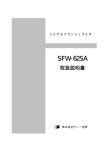

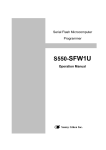

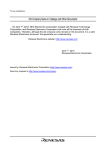
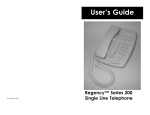


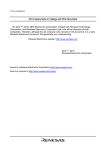

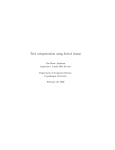
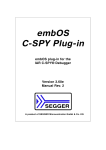
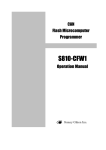
![[S3062PT-CPE-2] User`s Manual(First Edition): CPE62PSUE_2](http://vs1.manualzilla.com/store/data/005668190_1-0d028d6af383e5d06430420ca44dee4c-150x150.png)

